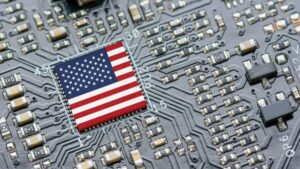The AI boom is set to supercharge these ASX semiconductor stocks
AI growth looks set to supercharge the semiconductor market. Picture via Getty Images
- We are on the cusp of a new AI era
- Semiconductor stocks on the ASX set to ride the boom
- This includes graphene, neuromorphic chips, and quantum computing
The semiconductor game’s about to level up, but not in the usual, cyclical way we’re used to seeing.
We’re looking at something bigger here. The kind of change that doesn’t just disrupt things for a quarter or two, but redefines the whole playing field.
This, experts say, is the start of a new era, one they believe will drive unstoppable growth.
We’re talking a US$1.2 trillion market by 2030 – driven by insane tech breakthroughs and an explosion in demand for chips that are powering everything from AI to next-gen gadgets.
By then, analysts believe semiconductors won’t be just the brains of devices anymore – they’ll be the engine of entire economies.
“Will generative AI surpass human creativity in a decade? How will our smartphones revolutionise daily life by 2035?” asked Billy Leung at Global X.
“All these intriguing possibilities hinge on the evolution of the semiconductor industry.”
AI to supercharge semis market
Right now, in the world of PCs and mobiles, semiconductors are barely taking a slice – 20-30% for PCs, and just 10-20% for mobiles.
But when it comes to AI, we’ll be looking at an opportunity that’s significantly larger and far more lucrative.
AI needs a lot more hardware to do its thing.
That means the semiconductor industry could suddenly own 40-50% of the tech stack’s total value, according to recent research from the Redline Group.
Smaller semiconductor players could cash in by solving problems around storage, memory, and specific computing needs.
“As the AI market continues to expand and evolve, investors who recognise its potential are well poised to reap the rewards of this exciting technological revolution,” said deVere Group’s Nigel Green.
“Including AI exposure in investment portfolios isn’t just a trend – it’s a strategic move that aligns with the future of innovation and economic growth.
“Just do it judiciously.”
ASX semiconductor stocks on the rise
As the AI revolution accelerates, semiconductor stocks on the ASX are also primed to ride this wave of growth.
The following four companies have been gaining traction, with their share prices moving in the right direction over the past six months. All are developing critical tech that could fuel AI advancements.
In alphabetical order, then, here’s the alpha…
Adisyn (ASX:AI1)
Adisyn’s stock has been on an absolute tear, flexing a 300% gain over the past 12 months.
The company made a major move in the semiconductor space by acquiring 2D Generation (2DG), an Israeli firm pioneering a breakthrough in graphene-based chip manufacturing.
Graphene, a super-conductive material, has long been seen as the key to revolutionising semiconductors, but its integration into production has been tricky – until now.
2DG has developed a patented process that grows graphene at temperatures below 300°C, a game-changer for semiconductor manufacturing.
This low-temperature technique allows graphene to be integrated into chips without damaging their delicate components.
“This low temperature is what sets us apart from everyone else,” Arye Kohavi, 2DG’s CEO, recently told Stockhead.
This breakthrough addresses one of the biggest challenges in semiconductor design – heat generation.
As chips shrink, interconnects between transistors become more prone to overheating. Graphene’s ability to conduct heat efficiently could replace copper in interconnects, preventing performance issues.
“If we want chips to keep getting faster, we need to solve the heat generation problem, and graphene can do that,” Kohavi added.
With the global semiconductor market expanding rapidly, 2DG’s innovation could open the door to a new era of faster, smaller, and more efficient chips.
If successful, this technology could significantly reshape the sector.
Read more: Adisyn’s 2D Generation is in the global race to bring graphene into advanced semiconductors
Archer Materials (ASX:AXE)
Quantum computing is quickly moving from science fiction to reality, and one Aussie company at the forefront is Archer Materials.
Archer is developing a unique carbon film that could potentially revolutionise quantum computing.
Archer’s chief technology officer, Dr Simon Ruffell, explained how this carbon film has exceptional quantum properties, including “very long spin lifetimes at room temperature”.
“This is a big deal because most quantum technologies require incredibly cold temperatures to work,” he told Stockhead.
The ability to operate at room temperature means the company can potentially use existing semiconductor manufacturing methods, drastically reducing both cost and complexity.
But it’s not just about computing.
Archer is also exploring quantum sensors, which have applications in fields ranging from healthcare to automotive.
These sensors, driven by TMR (Tunnel Magnetoresistance) technology, can measure magnetic fields with high sensitivity, making them useful for devices like MRI machines.
“Their potential goes far beyond med tech,” says Ruffell, with industries like automotive and solar power also in the mix.
In healthcare, Archer is currently working on a biochip designed to simplify chronic kidney disease testing.
“Right now, testing for kidney disease is a long and expensive process,” Ruffell noted.
Archer’s biochip allows people to perform tests at home, saving time and money. The team is currently navigating the regulatory hurdles, but aims to bring this game-changing product to market in the near future.
“We are pursuing four key themes: quantum technologies, healthcare, digitisation and decarbonisation. Each one of these has the potential to disrupt existing industries.”
BrainChip Holdings (ASX:BRN)
Brainchip’s Akida processor isn’t just another AI chip – it’s built to mimic how the brain works.
Akida processes data in real time, directly on devices. It uses neuromorphic tech, meaning it learns and adapts on the spot.
Instead of relying on bulky cloud servers to process data, Akida works at the edge – right where the action is happening.
Akida is also said to process data with far less energy, meaning devices run longer and perform better.
It can handle complex tasks like image recognition, anomaly detection, and even pattern recognition in real time.
BrainChip’s stock soared in December after two massive wins.
First, Frontgrade Gaisler licensed BrainChip’s Akida tech for space microchips, while teaming up with the European Space Agency to power space-based AI.
Then, the Air Force Research Laboratory dropped a $1.8 million contract to use Akida 2.0 for radar algorithms, backing up BrainChip’s growing presence in military and aerospace AI.
Weebit Nano (ASX:WBT)
Weebit aims to position itself at the forefront of the semiconductor market with its ReRAM technology.
CEO Coby Hanoch is optimistic about Weebit’s future, calling ReRAM “the next big thing” in memory technology.
The technology has the potential to replace traditional Flash memory in everything from AI to IoT, and high-performance computing.
“I believe, whether we like it or not, Weebit has become kind of a forefront of this crusade to make Australia understand the importance of semiconductors,” he said.
ReRAM offers superior performance—faster speeds, lower power consumption, and more cost-effective manufacturing compared to Flash.
Hanoch’s confident that demand for ReRAM will soon be universal: “It’s not a matter of if; I don’t think they have a choice. I mean, they all need ReRAM.”
Weebit’s partnerships with companies like DB HiTek are paving the way for future deals, and Hanoch’s personal stake is high.
“100% of my equity compensation is tied to performance.
“This is my way to show the shareholders my level of confidence in the potential of Weebit.”
All ASX chip stocks
(Data taken on January 13, 2025)
| Security | Description | Last | %Mth | %SixMth | %Yr | MktCap |
|---|---|---|---|---|---|---|
| WBT | Weebit Nano Ltd | 2.620 | -14% | 4% | -27% | $543,044,154 |
| AI1 | Adisyn Ltd | 0.070 | -14% | 150% | 312% | $43,210,121 |
| 4DS | 4Ds Memory Limited | 0.044 | -44% | -51% | -41% | $77,591,136 |
| BLG | Bluglass Limited | 0.025 | 0% | -31% | -55% | $46,006,809 |
| AXE | Archer Materials | 0.365 | 6% | 1% | 3% | $93,019,160 |
| BRN | Brainchip Ltd | 0.330 | 38% | 65% | 94% | $650,914,432 |
At Stockhead, we tell it like it is. While Adisyn is a Stockhead advertiser, it did not sponsor this article.
This article does not constitute financial product advice. You should consider obtaining independent advice before making any financial decisions.
Related Topics
UNLOCK INSIGHTS
Discover the untold stories of emerging ASX stocks.
Daily news and expert analysis, it's free to subscribe.
By proceeding, you confirm you understand that we handle personal information in accordance with our Privacy Policy.








